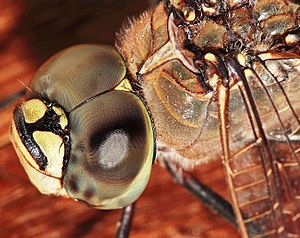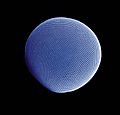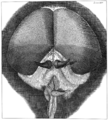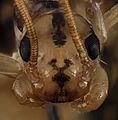Compound eye facts for kids


Compound eyes are special eyes found in many insects and other creatures like crabs. Instead of having one lens like our eyes, compound eyes are made up of hundreds or even thousands of tiny individual eye units. Each tiny unit is called an ommatidium (say: oh-mah-TID-ee-um).
Imagine looking through a honeycomb; that's a bit like how a compound eye is structured. Each ommatidium points in a slightly different direction. This allows the animal to see a very wide area, almost like having many small cameras working together. Compound eyes are also great at spotting quick movements and can even see polarized light, which helps some animals navigate.
Contents
What Are Compound Eyes?
Most animals, including humans, have eyes that can see clear images. About 96% of all animal species have some kind of complex eye system. You can find eyes that form images in animals like molluscs (like snails), chordates (like fish and humans), and arthropods (like insects and spiders).
Almost all insects and arachnids (spiders, scorpions) use both simple eyes and compound eyes. Simple eyes usually just detect light and dark, while compound eyes help them see detailed images.
Different Kinds of Compound Eyes
Compound eyes generally come in two main types:
- Apposition eyes: These eyes form many separate, upside-down images. Each ommatidium collects light from a small part of the scene.
- Superposition eyes: These eyes combine light from many ommatidia to form a single, upright image. This type is often found in animals that are active in dim light.
Compound eyes are very common in arthropods, like insects and crustaceans. They are also found in some worms (annelids) and certain types of clams (bivalved molluscs). As arthropods grow, their compound eyes get bigger by adding new ommatidia around the edges.
Eyes for Fast Fliers
Animals that are very good at flying, like flies and honey bees, or insects that hunt other creatures, such as praying mantises and dragonflies, have special areas in their compound eyes. These areas are like a "fovea" in our eyes, which gives them very sharp vision.
In these special sharp-vision zones, the eyes are flatter, and the individual ommatidia are larger. This flat shape allows more ommatidia to gather light from a single spot, which helps them see much clearer details. This is super helpful for catching prey or avoiding predators while flying at high speeds!
Other Unique Eye Types
There are also some other interesting types of eyes that look like compound eyes but are a bit different. For example, the Scutigera, also known as the house centipede, has what's called a "pseudofaceted eye." This eye is actually a group of many simple eyes (called ocelli) clustered together on each side of its head. They are arranged in a way that makes them look like a true compound eye.
Even more unusual, the body of Ophiocoma wendtii, a type of brittle star (which is related to starfish), is covered with ommatidia. This means its entire skin acts like one giant compound eye! Many chitons, which are marine molluscs, also have their whole skin covered in eye units.
Images for kids
-
Compound eye of Antarctic krill as imaged by an electron microscope
-
Head of a mantisfly showing a compound eye
-
Drawing from Robert Hooke's Micrographia of the compound eye of a grey drone fly
-
Compound eyes of a house centipede
See also
 In Spanish: Ojo compuesto para niños
In Spanish: Ojo compuesto para niños





